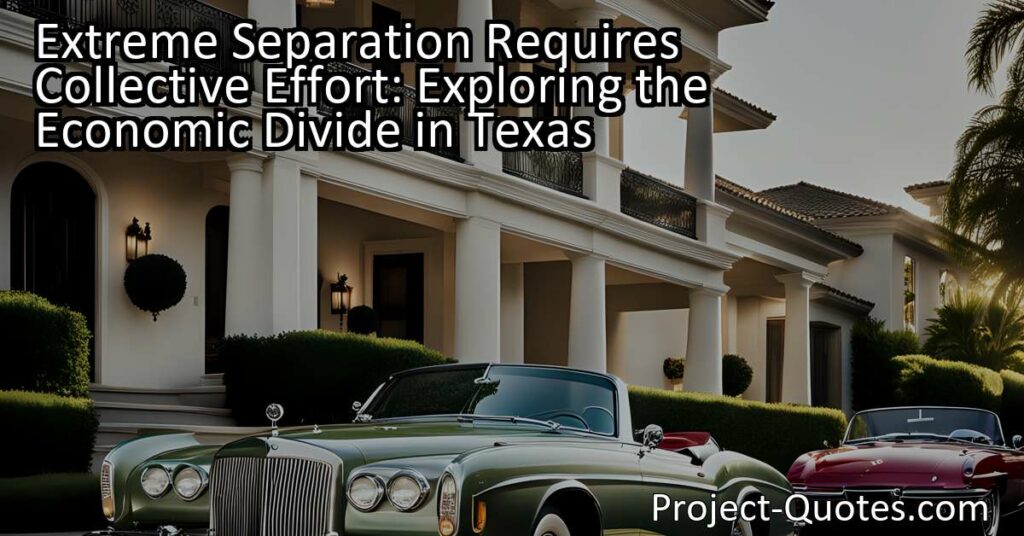Texas has arguably the most extreme separation between the well off and everyday people in the United States.
Don Baylor
Extreme Separation Requires Collective Effort: Exploring the Economic Divide in TexasTexas, the Lone Star State, is grappling with a significant economic divide that sets it apart from the rest of the United States. From historical factors to disparities in education and healthcare, this essay explores the root causes and consequences of the extreme separation. However, by emphasizing collective effort, comprehensive policies, and collaboration between sectors, Texas has the potential to bridge the gap and create an inclusive society that benefits all its residents.
Table of Contents
Meaning of Quote – Texas has arguably the most extreme separation between the well off and everyday people in the United States.
Texas, the Lone Star State, is known for its vast landscapes, rich history, and vibrant culture. However, beneath its picturesque facade lies a stark reality – a deep-seated economic divide that sets it apart from the rest of the United States. As Don Baylor, a renowned author, once pointed out, Texas has arguably the most extreme separation between the well-off and everyday people in the country.
When we delve into the complex dynamics of wealth distribution and social inequality, it becomes evident that Texas faces unique challenges. From the glittering skyscrapers of downtown Houston to the small, neglected towns dotting the rural countryside, the contrast is undeniable. In this essay, we will explore the reasons behind this extreme separation, its consequences, and potential solutions that could pave the way towards a more egalitarian Texas.
The roots of Texas’ economic divide can be traced back to its historical development. Texas, once a part of Mexico, was annexed as a state in 1845, and it quickly became a center for agriculture and ranching. The state’s vast natural resources, including fertile soil and an abundance of livestock, attracted settlers from various ethnic backgrounds. This rapid settlement and economic growth laid the foundation for the divide we see today.
Throughout its history, Texas has been heavily reliant on industries such as oil, natural gas, and agriculture. These sectors have propelled the state’s economy and brought tremendous wealth to a select few. However, they have also contributed to the ever-widening gap between the wealthy elite and the average Texan. The concentration of wealth in the hands of a small minority has further exacerbated the disparities in educational opportunities, healthcare accessibility, and overall quality of life for many Texans.
Education, or the lack thereof, plays a crucial role in perpetuating the economic divide within the state. While Texas is home to several world-class universities and academic institutions, the majority of its public schools struggle to provide quality education, especially in low-income areas. The stark contrast between underfunded schools in impoverished neighborhoods and well-resourced schools in affluent communities creates an uneven playing field for students, with far-reaching consequences.
In addition to education, access to healthcare is another pressing issue that highlights the extreme separation within Texas. The state consistently ranks among the lowest in terms of healthcare coverage and access. This disproportionately affects low-income communities, leading to inadequate medical assistance, higher rates of chronic illnesses, and ultimately, a lower quality of life. The vast economic disparities across the state make it increasingly challenging for everyday Texans to bridge the gap and ensure their well-being.
The consequences of this extreme separation extend beyond education and healthcare. Financial insecurity, limited job opportunities, and inadequate public infrastructure are common challenges faced by many Texans. Moreover, marginalized communities, including people of color and immigrants, often find themselves at a greater disadvantage. They face systemic barriers that prevent upward mobility and perpetuate a cycle of poverty, further widening the gap between the well-off and those struggling to make ends meet.
It is essential to recognize that addressing this extreme separation requires collective effort and comprehensive policies. Grassroots movements and advocacy groups have emerged to shed light on the inequalities within Texas. They not only aim to raise awareness but also push for systemic changes that can lead to a more equitable society. These efforts include lobbying for fair taxation, improving funding for public education, expanding Medicaid coverage, and investing in infrastructure projects that benefit all Texans, regardless of their socioeconomic status.
Moreover, it is crucial for both the government and private sector to actively seek solutions and allocate resources accordingly. Creating an environment that promotes economic diversity and innovation is key to alleviating the economic disparities that plague the state. By investing in job creation, supporting small businesses, and nurturing entrepreneurship, Texas can foster an inclusive economy that benefits all its residents.
Furthermore, collaboration between different sectors is vital for addressing the root causes of the economic divide. Encouraging partnerships between businesses, nonprofit organizations, and educational institutions can help bridge the gap between the well-off and everyday people. This cooperative approach can lead to initiatives such as providing scholarships and mentorship programs for underprivileged students, ensuring access to affordable housing, and establishing community centers that offer job training and other resources.
In conclusion, Don Baylor’s observation about Texas having arguably the most extreme separation between the well-off and everyday people in the United States sheds light on an issue that demands our attention. The state’s historical trajectory, reliance on specific industries, and systemic inequalities have all contributed to this alarming reality. Nevertheless, Texas has the potential to rise above its economic divide and foster a more inclusive society. By prioritizing quality education, accessible healthcare, and comprehensive policymaking, the Lone Star State can embrace a brighter future where opportunities are available to all, regardless of their background or economic status. It’s time for Texas to bridge the gap and truly become a beacon of equality and prosperity for all its residents.
I hope this quote inspired image brings you hope and peace. Share it with someone who needs it today!


